|
Recent development in battery valves.

Latest additions to the Mazda range of battery valves.
A number of interesting new valves of particular appeal to the battery user will shortly be marketed by Mazda. The first of these is the TP22, a combination of an HF pentode and a triode valve in the same bulb. This valve is intended to act as a frequency-changer, and it is fitted with a 9-pin base. It consumes 0.25 A at 2 Volts for its filament, and is rated for 150 Volts on both anode and screen. Under normal conditions, however, the valve is recommended for use with an anode potential of 120 Volts, and with 60 Volts applied to the screen. The pentode anode current is then 1.0 mA., and the oscillator consumes a further 0.6 mA, the conversion conductance reaching the figure of 0.5 mA/V. The price is 18s. 6d.
The next valve in the series is a variable-μ HF pentode, the VP215, and this also is rated for 150 Volts on both anode and screen. It is fitted with a 7-pin base, and its filament consumes 0.15 A. At an anode potential of 120 volts, the anode current is only 1.1 mA, when 60 Volts are applied to the screen and a negative grid bias of 1. 5 Volts is used. The mutual conductance is rated at 1.8 mA/V.
The SP215 is a non-variable-μ HF pentode with similar voltage ratings. This valve also has a 7-pin base, and it is intended to act chiefly as a frequency-changer with cathode injection, in which case the heterodyne Volts should be 2.5 Volts peak for a conversion conductance of 0.65 mA/V. It may, of course, be used as an HFor IF amplifier in sets in which volume control is not obtained by a variation of grid bias. Both the HF pentodes are listed at 15s. 6d.
The Duo-Diode-Triodes
A duo-diode-triode, the HL21DD, is included in the range, and separate filaments are used for the diodes and the triode. The total filament current is 0.15 A, and the triode is rated for 150 Volts maximum anode potential. It has a mutual conductance of 1.5 mA/V with an AC resistance of 21,000 Ω.
The characteristics of the two diodes are not the same, and one starts to pass current at a negative potential of about 0.6 Volt, whereas the other does not become conductive until a positive potential of about 0.4 Volt is applied. The first diode is consequently intended to act as a detector, while the second is used for AVC purposes. Additional bias can be applied to increase the delay, but with the diode load returned to negative LT a delay of 0.4 Volt is obtained automatically. A second duo-diode-triode, the L21DD, is also available; the only difference is in the triode characteristics which are suitable for a driver valve in Class B operation. The AC resistance is 10,000 Ω, and the mutual conductance 1.8 mA/V. The price of both these valves is the same, 9s.
The last valve in this range is the QP240, a double-pentode output valve of the quiescent push-pull type, fitted with a 9-pin base, The filament consumption is 0.4 A, and the valve is rated for screen and anode potentials of 150 Volts. The screens are brought out to separate pins in the base, so that the pentodes can be matched by applying different screen voltages to the two valves.
A system of grading is adopted in manufacture, and letters indicating the recommended operating voltages for that particular valve are marked on the bulb. The valve is used normally with an anode supply of 135 Volts and a grid bias of -10.3 Volts. The letter 'P' on the bulb then indicates that 103.5 Volts should be applied to the particular screen to which it refers: Q indicates 111 Volts; R, 118.5 Volts; S, 126 Volts; and T, 133.5 Volts.
Under these conditions the anode-to-anode load impedance should be 20,000 Ω, and the total quiescent anode current is 3.8 mA. The power output is about 1,300 milliWatts, and the value is priced at 22s, 6d.
|